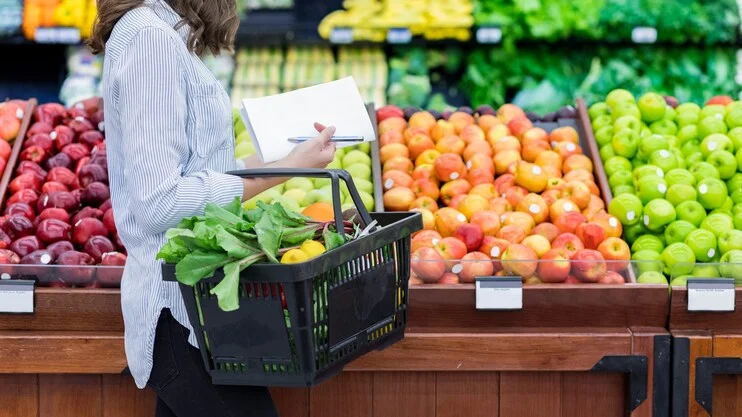Grocery shopping in South Africa has become a financial tightrope. With food inflation hitting 8.1% in February 2024, according to Statistics South Africa (Stats SA), families across the country are feeling the pinch. From soaring prices for staples like maize meal to eye-watering costs for eggs, keeping the pantry stocked without breaking the bank feels harder than ever. For many, the rising cost of food threatens not just budgets but also the ability to maintain a nutritious diet.
This is a real problem. Low- and middle-income households, who spend over 30% of their income on food (Pietermaritzburg Economic Justice & Dignity Group, PMBEJD), are hit hardest. The temptation to cut corners by buying cheap, processed foods is strong, but this often comes at the expense of health. So, how do you save money on groceries while still eating well?
In this blog post, we’ll share practical, data-backed strategies to help you cut grocery costs without sacrificing nutrition. Expect smart tips, real-world examples, and free tools to make your shopping trips more affordable and your meals healthier. Whether you’re feeding a family or flying solo, these ideas will empower you to shop smarter and stretch your rands further.
Understanding the Grocery Price Landscape in South Africa
To tackle grocery costs, it’s crucial to understand what’s driving them. Food inflation in South Africa is relentless, with certain categories hit harder than others. According to Stats SA’s Food Inflation Report (February 2024):
- Bread and cereals (including maize meal and rice) have seen price hikes of up to 16%.
- Meat remains a major contributor to inflation, with beef and chicken prices climbing steadily.
- Eggs have skyrocketed, with a 25% price increase year-on-year, making this protein staple less accessible.
These increases hit low- and middle-income households hardest. The PMBEJD notes that families earning modest incomes dedicate a disproportionate share of their budgets to food, leaving little room for other essentials. As a result, many turn to cheaper, ultra-processed foods like instant noodles, sugary drinks, and vetkoek. While these options are budget-friendly in the short term, they contribute to nutritional insecurity, with long-term consequences like obesity, diabetes, and malnutrition.
The challenge is clear: how do you maintain a balanced, nutrient-rich diet when prices keep climbing? The good news is that with the right strategies, you can save money and still eat healthily.
The Hidden Costs of Cheap Food
Before diving into solutions, let’s address a common trap: opting for the cheapest foods available. While processed, high-sugar, and low-nutrient foods like chips, sugary cereals, and instant meals are often more affordable, they come with hidden costs. These foods may fill you up, but they lack the nutritional density needed for long-term health. Over time, reliance on these options can lead to:
- Health issues: Poor nutrition is linked to chronic conditions like diabetes and heart disease, which increase medical expenses.
- Reduced productivity: Nutrient deficiencies can cause fatigue, poor concentration, and frequent sick days.
- Impact on kids: Children raised on low-nutrient diets may struggle with growth, learning, and development.
In South Africa, this is a growing concern. The PMBEJD reports that popular low-cost foods like vetkoek, white bread, and sugary drinks dominate shopping baskets in lower-income communities, contributing to malnutrition even when calories are abundant.
The key insight? Low-cost doesn’t have to mean low-quality. By prioritizing nutrient-dense foods and shopping strategically, you can eat well without overspending.
Practical, Nutrient-Conscious Cost-Saving Tips
Here are six actionable strategies to help you save money on groceries while keeping nutrition first. These tips are tailored to South Africa’s unique food landscape and backed by data and local insights.
1. Shop with a Plan
Impulse buys are the enemy of a tight budget. Studies show that shoppers without a plan spend 20–30% more than those with a list. To avoid this:
- Create a weekly meal plan: Map out breakfast, lunch, and dinner for the week, focusing on affordable, nutrient-rich ingredients like lentils, seasonal vegetables, and whole grains.
- Stick to a grocery list: Write down exactly what you need and resist tempting in-store promotions.
- Use apps: Tools like Mealime or Yummly offer meal plans tailored to South African ingredients, helping you plan healthy, budget-friendly meals.
Pro tip: Plan meals around versatile staples like maize meal, beans, or cabbage, which are affordable and nutrient-packed.
2. Buy Seasonal and Local
Seasonal produce is not only fresher but also significantly cheaper—often 30–50% less than out-of-season items, as it avoids costly imports and storage. For example, in winter, cabbage, spinach, and citrus fruits like naartjies are abundant and affordable, while in summer, mangoes, tomatoes, and green beans are at their peak. According to the Department of Agriculture, Land Reform and Rural Development (DALRRD), seasonal buying supports local farmers and reduces transport costs, keeping prices low. Check out a seasonal produce chart (linked in the resources section below) to plan your shopping. Shopping at local farmers’ markets, such as the Oranjezicht City Farm Market in Cape Town or the Bryanston Organic Market in Johannesburg, offers even better deals, with prices often 10–20% lower than supermarkets and room for negotiation. These markets also provide fresher, pesticide-free produce, ensuring better nutrition. For instance, a bunch of kale at a market can cost R15 compared to R25 at a retailer. Local insight: Supporting small-scale farmers not only saves money but also strengthens community food systems and reduces reliance on expensive, imported goods.
3. Leverage Store Brands and Loyalty Programs
Major South African retailers offer store brands and loyalty programs that can significantly reduce your grocery bill. For example, Pick n Pay’s Smart Shopper, Checkers Xtra Savings, and Woolworths WRewards provide 10–20% discounts on essentials like rice, canned goods, and household items, with some promotions offering up to 50% off on specific products, according to BusinessTech SA (2023). House brands, such as Woolworths’ Essentials, Spar’s house brand, or Shoprite’s Ritebrand, are up to 25% cheaper than name brands while maintaining comparable quality. For instance, a 2kg bag of Ritebrand rice costs around R30 compared to R40 for a premium brand. Many retailers also offer personalized discounts through their apps, tailoring deals to your shopping habits. Signing up is free and takes minutes, yet it unlocks exclusive savings. Pro tip: Always compare unit prices (price per kilogram or liter) to ensure the best deal, and check loyalty program apps before shopping to stack discounts on frequently bought items like maize meal or milk.
4. Bulk Buy Smart (Not Everything!)
Buying in bulk can save you money, but only if you choose wisely. Focus on non-perishables with a long shelf life that your household uses regularly, such as rice, lentils, beans, maize meal, pasta, and cooking oil. For example, a 10kg bag of rice can cost R100 in bulk (R10/kg) compared to R15/kg for smaller packs, saving you 33%, according to Checkers’ 2024 pricing data. Similarly, bulk-buying dried legumes like lentils or chickpeas can cut costs by 20–30% compared to smaller portions.
However, avoid bulk-buying perishables like fresh produce or dairy unless you’re prepared to meal prep or freeze them. For instance, buying a large tray of chicken breasts is only cost-effective if you portion and freeze it to prevent spoilage. Pro tip: Share bulk purchases with friends, neighbors, or family to split costs and reduce waste, or invest in airtight containers to keep bulk goods fresh longer. Check warehouse retailers like Makro or Food Lover’s Market for competitive bulk deals, but always calculate the unit price to confirm savings.
5. Cook from Scratch
Cooking from scratch is one of the most effective ways to save money and boost nutrition. Store-bought convenience foods are often marked up significantly. For example:
- A homemade loaf of bread costs around R6 to make (flour, yeast, water) compared to R18+ for a store-bought loaf.
- Homemade yogurt can be made for less than R10 per liter, versus R30+ for commercial brands.
- Soups and stews made with affordable ingredients like lentils, carrots, and potatoes are nutrient-dense and cost pennies per serving.
Local recipe idea: Try a hearty samp and bean stew, a South African classic that’s cheap, filling, and packed with protein and fiber.
6. Grow Some of Your Own Food
Even if you live in a township or a small flat, container gardening can reduce your grocery bill. Growing herbs (parsley, basil), leafy greens (spinach, kale), or cherry tomatoes in pots is low-cost and requires minimal space. A packet of seeds costs R20–R30 and can yield months of fresh produce.
Organizations like Food & Trees for Africa support urban gardening initiatives, offering resources and training for beginners. Not only does this save money, but it also ensures access to fresh, pesticide-free produce.
Pro tip: Start with easy-to-grow crops like spinach or rocket, which thrive in small spaces and are ready to harvest in weeks.
The Long-Term Value of Nutritional Prioritization
Prioritizing nutrition when grocery shopping is more than just a way to save money today—it’s an investment in your family’s long-term health and success. Eating nutrient-rich foods like vegetables, legumes, and whole grains strengthens immunity, leading to fewer sick days and lower medical costs. For kids, a balanced diet improves focus and boosts academic performance, setting them up for a brighter future. Plus, choosing whole foods over processed options reduces the risk of chronic conditions like obesity, diabetes, and heart disease. By focusing on nutrition now, you’re building a healthier, more productive life for yourself and your loved ones.
Free Tools & Resources
To make these cost-saving strategies even easier to implement, here are free, practical resources tailored for South African shoppers. These tools and guides will help you plan, shop, and cook smarter, ensuring you save money while keeping nutrition first.
- Downloadable Grocery Planner Template: These customizable weekly planners help you map out meals, create a budget-friendly shopping list, and avoid impulse buys. Some of them include sections for staples (e.g., maize meal, beans) and seasonal produce, plus a budget tracker to monitor spending. Based on user feedback, shoppers using planners cut spending by up to 20% (Retail Consumer Studies, 2023).
- South African Seasonal Produce Calendar: A detailed guide to what’s in season each month, helping you buy the cheapest, freshest produce. For example, it highlights spinach and oranges in winter and tomatoes and peaches in summer. Sourced from the South African Fruit and Vegetable Growers’ Association, this calendar ensures you plan meals around affordable ingredients.
- Budget-Friendly, Nutrient-Dense Recipes: Try these South African-inspired dishes that maximize nutrition on a budget:
- Chakalaka with Beans: A spicy, veggie-packed dish using canned beans (R12/can) and seasonal carrots and peppers (R10/kg). Costs ~R25 for four servings, rich in fiber and vitamins.
- Lentil and Butternut Stew: Combines bulk-bought lentils (R20/kg) with winter butternut (R8/kg). Costs ~R30 for six servings, high in protein and antioxidants (recipe from Woolworths Taste).
- Pap with Tomato-Onion Relish: A filling staple using maize meal (R10/kg) and summer tomatoes (R12/kg). Costs ~R15 for four servings, providing energy and micronutrients.
- Urban Gardening Starter Guide: A beginner’s guide to growing your own herbs, spinach, or cherry tomatoes in small spaces, even in townships or flats. Includes tips on container gardening and seed sourcing (e.g., R25 seed packets from Livingseeds.co.za). Provided by Food & Trees for Africa (www.trees.org.za), this guide helps you cut veggie costs by up to R150/month.
These resources are designed to empower you with practical tools, saving you time and money while keeping your meals healthy and delicious.
Rising grocery prices don’t have to mean sacrificing nutrition. By planning your meals, buying seasonal and local, leveraging store deals, cooking from scratch, and even growing a few crops, you can cut costs while keeping your family healthy. Real-world examples like Naledi’s show that these strategies work, and the long-term benefits—fewer sick days, better school performance, and lower healthcare costs—are worth the effort.
You don’t need to overhaul your life to save money on groceries. Start small, shop with purpose, and watch your rands stretch further. With a little strategy, you can feed your family well and still have money left in your pocket.


